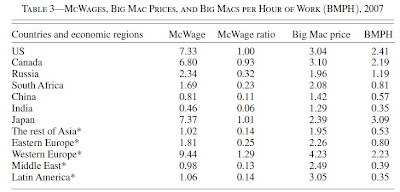From The Conversable Economist:
McWages Around the World
It's hard to compare wages in different countries, because the details of the job differ. A typical job in a manufacturing facility, for example, is a rather different experience in China, Germany, Michigan, or Brazil. But for about a decade, Orley Ashenfelter has been looking at one set of jobs that are extremely similar across countries--jobs at McDonald's restaurants. He discussed this research and a broader agenda of "Comparing Real Wage Rates" across countries in his Presidential Address last January to the American Economic Association meetings in Chicago. The talk has now been published in the April 2012 issue of the American Economic Review, which will be available to many academics through their library subscription. But the talk is also freely available to the public here as Working Paper #570 from the Princeton's Industrial Relations Section....
... Ashenfelter has built up McWages data from about 60 countries. Here is a table of comparisons. The first column shows the hourly wage of a crew member at McDonald's, expressed in U.S. dollars (using the then-current exchange rate). The second column is the wage relative to the U.S. wage level, where the U.S. wage is 1.00. The third column is the price of a Big Mac in that country, again converted to U.S. dollars. And the fourth column is the McWage divided by the price of a Big Mac--as a rough-and-ready way of measuring the buying power of the wage.
Ashenfelter sums up this data, and I will put the last line in boldface type:
"There are three obvious, dramatic conclusions that it is easy to draw from the comparison of wage rates in Table 3. First, the developed countries, including the US, Canada, Japan, and Western Europe have quite similar wage rates, whether measured in dollars or in BMPH. In these countries a worker earned between 2 and 3 Big Macs per hour of work, and with the exception of Western Europe with its highly regulated wage structure, earned around $7 an hour. A second conclusion is that the vast majority of workers, including those in India, China, Latin America, and the Middle East earned about 10% as much as the workers in developed countries, although the BMPH comparison increases this ratio to about 15%, as would any purchasing-power-price adjustment. Finally, workers in Russia, Eastern Europe, and South Africa face wage rates about 25 to 35% of those in the developed countries, although again the BMPH comparison increases this ratio somewhat. In sum, the data in Table 3 provide transparent and credible evidence that workers doing the same tasks and producing the same output using identical technologies are paid vastly different wage rates."......MORE
Read on to see why the bolded bit is, bolded.
I'm not sure McDonald' wants to be associated with this but we'll leave the stock symbol in the title until we hear from their attorneys.
I'm guessing that they haven't copyrighted McJobs or McWages.
